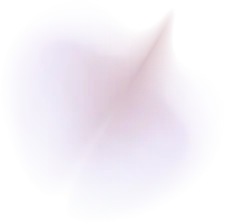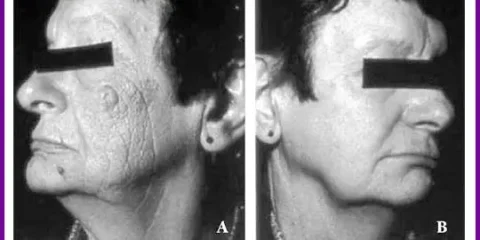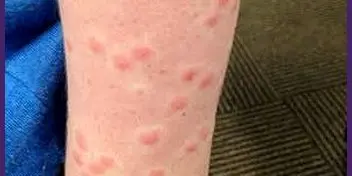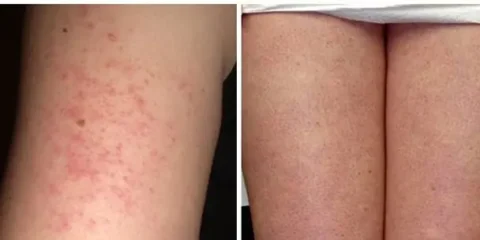
When skin is looking tired, blemishes are out of control, or your skin just needs a pick-me-up, a chemical facial peel can be the solution to your skin’s cry for help. If you are new to the skincare process or are curious if the treatment may be right for you, you may be wondering how it all works. Skincare professionals can help you determine your skin’s needs and provide you with a treatment plan, and our guide below serves as a closer look at chemical face peels.
What is a Chemical Face Peel?
With so many skincare products and treatments on the market it can be difficult to discern between the purpose and promises of each one. A chemical peel, as its name suggests, is the process of applying acids to the skin to resurface and rejuvenate the skin and may cause peeling. This treatment helps to remove damaged skin cells and stimulate cell turnover to reveal fresh, beautiful skin.
There are different levels of strength and skin penetration depending on the method and type of acid applied. We will dive deeper into the different types of chemical peels later in this guide.
Benefits of Chemical Peels
If you are wondering if a chemical peel is right for you, you’ll want to determine what your skincare goals are. Chemical peels have many benefits and target several different skin concerns. The treatment can be done on different areas including the face, neck, or hands. Chemical peels can be used to:
- Reduce the appearance of fine lines and wrinkles from aging and sun damage
- Reduce the appearance of mild facial scars
- Improve acne and breakouts
- Reduce the appearance of acne scars, age spots, freckles, dark spots or other discoloration
- Improve overall appearance and texture of skin
- Stimulates new collagen and healthy skin cell growth
- Improves skin hydration
- Enabling home skincare products to penetrate deeper into the skin, improving effectiveness
Types of Chemical Peels
Depending on the individual goals, severity of skin concern, and your skincare professional’s assessment, the recommended type of chemical peel can differ. There are three main types of peels; light, medium and deep. The different levels of acids used and level of skin penetration can be used to target mild to severe concerns.
Generally, the stronger the acid and the deeper layer of skin penetrated, the peel will have a stronger effect. A strong peel may not be right for all candidates and sometimes a more mild option may do the trick. Your skincare consultant can recommend the best type of chemical face peel.
Types of chemical peels from most mild to deepest include:
Light
A light peel is most commonly performed, and is the mildest of the peel formulas. A light peel is typically beneficial for reducing very fine lines, improving dry skin, mild texture and discoloration, and acne. Acids used for light peels include:
- Alpha Hydroxy Acids (AHAs) – usually derived from fruits and other naturally occurring materials, AHAs are used for the most mild forms of chemical peel. Typically, these peels use citric, glycolic, lactic, malic, or tartaric acids.
- Beta Hydroxy Acids (BHAs) – the most widely used acid for a BHA peel is salicylic. Salicylic acid is most beneficial on oily skin types as it helps to control oil production. This acid is great on acne prone and congested skin as it helps to clear pores.
- Jessner’s Peels – this kind of peel is typically a combination of lactic acid, salicylic acid and resorcinol. This may be an ideal peel for darker skin, a modified Jessner’s solution may safely and effectively reduce melasma and pigment imperfections in darker skin. The Jessner is also considered a great chemical peel for acne scars. Depending on the concentration, a Jessner’s Peel can be considered a medium peel.
Medium
A medium peel is generally performed only once every couple of years using a trichloroacetic acid. Because of deeper penetration, it can remove larger wrinkles and precancerous skin lesions; however, this peel can make the skin temporarily look like a sunburn. Acids used for medium peels include:
- Trichloroacetic Acid Peels (TCA) – most medium depth peels use TCA. Typically combined with BHAs like salicylic acid. This treatment is ideal for advanced discoloration or damage, noticeable wrinkles and acne scars. Medium deep peeling can sting mildly with much warmer sensations on the skin.
Deep
Deep chemical peels, although rarely used anymore since the advancement of laser applications, uses Phenol. The application is very painful and is done under a general anesthesia. Acids used for deep peels include:
- Phenol peels – this is the strongest type of chemical peel solutions. Used for a deep skin peel, phenol peels are very powerful and can provide dramatic facial rejuvenation with long lasting results. Typically, this type of peel is administered by a physician and not an aesthetician as you may need a local anesthetic and a sedative during the procedure.
Keep in mind, the type and strength of the acid used will determine whether the chemical peel can safely be performed by a licensed aesthetician. Deeper chemical peels may only be administered by a licensed physician in many cases.
Chemical Peel FAQ’s
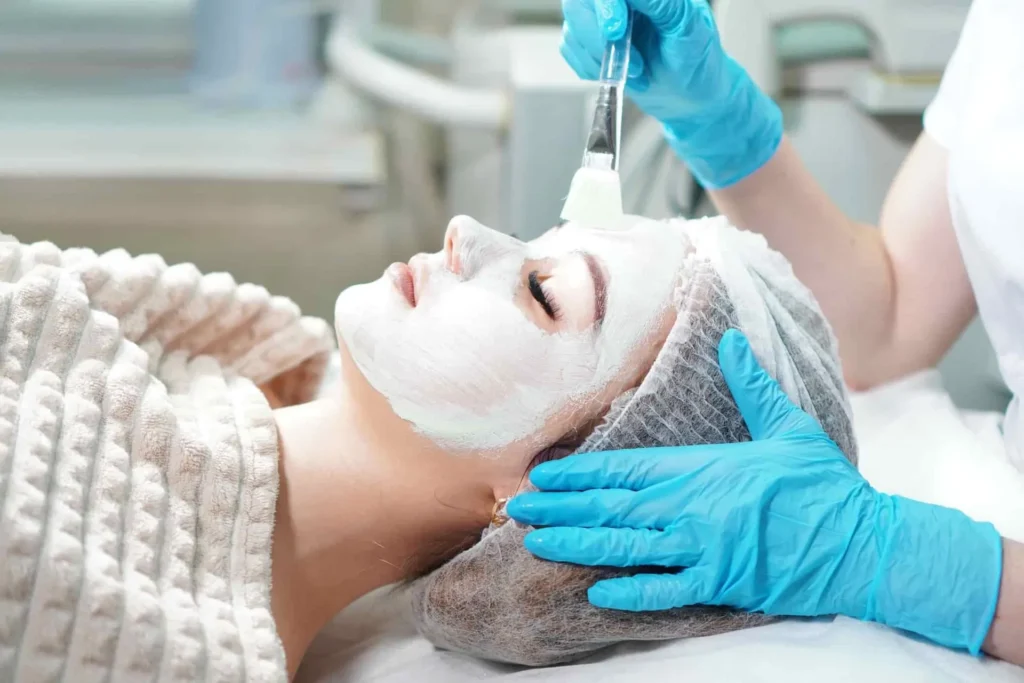
A chemical peel can seem like a scary procedure, conjuring up images of red-faced women commonly seen on TV (hello, Samantha Jones), but with the right information you can feel comfortable getting started. Some common questions people have about chemical peels include:
What is the recovery process of a chemical peel?
The recovery process differs based on the type of peel.
For light:
Time to heal is 1 to 7 days. Skin will be red after the peel, but redness goes away and scaling may develop. Lotion or cream should be applied until the skin heals, followed by daily sunscreen. Usually you can wear makeup immediately after the peel. No follow-up is needed. However, 3 to 5 peels may be necessary to give you the desired results. These peels may be repeated every 2 to 5 weeks.
For medium:
Time to heal is 7 to 14 days. Skin will be red and swollen after the peel and you may experience blisters that form and break open. Skin crusts and peels off in 7 to 14 days. Daily soaks of the skin are advised for a specified period and you should apply ointment after each soak. You will likely be prescribed an antiviral medication for 10 to 14 days. You should apply lotion or cream to the skin and completely avoid the sun until skin heals. You may begin to wear makeup after 5 to 7 days. A follow-up visit is required after this type of peel.
For deep:
Time to heal is 14 to 21 days. After the peel, your skin will be bandaged. While healing, 4 to 6 daily soaks are recommended. For 2 weeks after the treatment, apply ointment after each soak and after 14 days you may apply thick moisturizer as directed. You will need to take an antiviral medication for 10 to 14 days and totally avoid the sun for 3 to 6 months after the peel. You must wait at least 14 days before you begin to wear makeup. Your physician will want to do a follow-up the following day and several times during the first week.
What after care do I need for a chemical peel?
All chemical peels that require some at-home care. The after care will differ based on the chemicals used and your own skin’s needs. Your skincare professional should detail how to care for your skin post-peel, but some general tips include:
- Apply moisturizer as directed to keep your skin hydrated.
- Avoid tanning beds and other types of indoor tanning and limit sun exposure.
- Once healed, apply a sunscreen every day.
- If you experience burning, itching, or swelling, contact your skin care professional. Do not rub or scratch skin as it can lead an infection.
Who is an ideal candidate for chemical peels?
For optimal results, fair-skinned and light-haired patients are better candidates for chemical peels. However, if you have darker skin, you may find successful results depending on the type of peel–such as a Jessner peel–and skin concern you wish to treat. Generally, if you have darker skin you may be more likely to have an uneven skin tone after your peel.
Can I get a chemical peel while pregnant?
It depends. If you are pregnant, you should always consult with your doctor before any chemical peel. Generally, light chemical peels can be considered safe during pregnancy. The acid in these peels stay active for no more than five minutes and does not cause any harm to you or the fetus. Deeper peels should be considered strictly off limits for those who are pregnant. It is also recommended to avoid peels that contain salicylic acid. These acids and deep peels can permeate your skin and have an affect on the fetus.
Are there side effects of a chemical peel?
Chemical peels tend to produce little to no side effects and when they do appear they tend not to be severe. Some common side effects include:
- Persistent redness that may last for months.
- Temporary darkening of the skin.
- Lighter skin color (medium and deep peels).
- Scarring (very rare when peel performed by a dermatologist)
When can you see results and how long will they last?
You will see the results of your chemical peel when your skin is fully healed. Healing time may vary from 1 day to up to 21 days. For lighter peels, you may need to get several treatments to get the desired results.
The results of your chemical peel will always depend on your skin type, skin condition and the concerns you wish to treat with chemical peels. However, most results will not be permanent as our skin continues to age. Lighter peels last up to 2 months, medium up to 6 months, and deeper peels can last several years.
Chemical Peels at Allure
Rejuvenate and refresh your skin with a chemical peel from Allure Medical. There are two basic types of chemical solutions we offer to our patients: Alpha Hydroxy Acids (AHA) and A Trichloroacetic Acid (TCA).
More severe wrinkles do not respond well to chemical peels. For deeper wrinkles we recommend other kinds of cosmetic surgical procedures, such as the use of skin resurfacing lasers or Botox®.
Sources:
https://www.aad.org/public/cosmetic/younger-looking/chemical-peels-faqs
https://www.uwhealth.org/madison-plastic-surgery/chemical-peels/44542
https://www.skinspirit.com/blog/top-8-benefits-of-a-chemical-peel/
https://www.webmd.com/beauty/cosmetic-procedures-chemical-peel-treatments#1
https://shorthillsderm.com/blog/dermatology/how-long-do-chemical-peel-results-last
https://beautymadesimply.com/peel-so-good-understanding-the-different-types-of-chemical-peels/
https://www.plasticsurgery.org/cosmetic-procedures/chemical-peel/deep https://tvtropes.org/pmwiki/pmwiki.php/Main/CosmeticHorror



